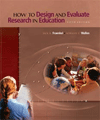 |  How to Design and Evaluate Research in Education, 5/e Jack R. Fraenkel,
San Francisco State University
Norman E. Wallen,
San Francisco State University
Reviewing the Literature
Main PointsThe Value of a Literature Review - A literature review helps researchers learn what others have written about a topic. It also lets researchers see what have been the results of other, related studies.
- A detailed literature review is often required of master's ad doctoral students when they design a thesis.
Type of Sources for a Literature Review - Researchers need to be familiar with three basic types of sources (general references, primary sources, and secondary sources) in doing a literature review.
- General references are sources a researcher consults to locate other sources.
- Primary sources are publications in which researchers report the results of their investigations. Most primary source material is located in journal articles.
- Secondary sources refer to publications in which authors describe the work of others.
- Education Index and CIJE are two of the most frequently used general references in educational research.
- Search terms, or "descriptors" are words researchers use to help locate relevant primary sources.
Steps Involved in a Literature Search - The essential steps involved in a review of the literature include: (1) defining the research problem as precisely as possible; (2) pursuing the secondary sources; (3) selecting and pursuing an appropriate general reference; (4) formulating search terms; (5) searching the general references for relevant primary sources; (6) obtaining and reading the primary sources, and noting and summarizing key points in the sources.
Ways to Do a Literature Search - Today, there are two main ways to do a literature search -- manually, using the traditional paper approach, and electronically, by means of a computer.
- There are five essential points (problem, hypothesis, procedures, findings, conclusions) that researchers should record when taking notes on a study.
Doing a Computer Search - Computer searches of the literature have a number of advantages -- they are fast, are fairly inexpensive, provide printouts, and enable researchers to search using more than one descriptor at a time.
- The steps in a computer search are similar to those in a manual search, except much of the work is done by a computer.
- Researching the World Wide Web (WWW) should be considered, in addition to ERIK and PsycINFO, in doing a literature search.
- Some of the Information on the Web is classified into directories, which group websites together under similar categories. Yahoo! is an example of a directory.
- To obtain more specific information, search engines should be used, because they search all of the contents of a website.
The Literature Review Report - The literature review report consists of an introduction, the body of the review, a summary, the researcher's conclusions, and a bibliography.
- When a researcher does a meta-analysis, he or she averages the results of a group of selected studies to get an overall index of outcome or relationship.
- A literature review should include a search for relevant meta-analysis reports, as well as individual studies.
|
|



 2003 McGraw-Hill Higher Education
2003 McGraw-Hill Higher Education